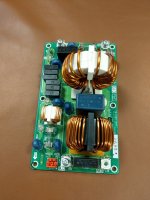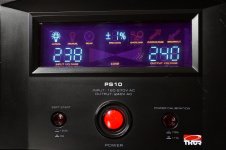None, but it is great fodder for armchair argument, conjecture etc from those inexperienced in the benefits. I run screened toroidal isolation transformers with line filters recovered from old aircon split system outdoor units. I also run a motorised autotransformer AC voltage regulator with associated power filter power board. Each of these units contributes goodness (reduction/clearing) of AC line noise and this manifests as cleaner, clearer, more detailed and relaxed presentation than direct AC power connection. Sometime I will try connecting two toroids back to back with additional filtering and see what results I get. Filtering/isolation is worth the expense IME.I hope people apply the AC isolation/filtering concept to their music systems. Or what is the point in even talking about it?
Dan.
None, but it is great fodder for armchair argument, conjecture etc from those inexperienced in the benefits. I run screened toroidal isolation transformers with line filters recovered from old aircon split system outdoor units. I also run a motorised autotransformer AC voltage regulator with associated power filter power board. Each of these units contributes goodness (reduction/clearing) of AC line noise and this manifests as cleaner, clearer, more detailed and relaxed presentation than direct AC power connection. Sometime I will try connecting two toroid's back to back with additional filtering and see what results I get. Filtering/isolation is worth the expense IME.
Dan.
🙂 😎 Welcome dear extremist.
maybe for some low power things. A bunch of car batteries in the room for your PA?
nah.
-RM
You forget, I listen at an average 100mW 🙂
Wide band Inductive probe coupled to network/spectrum analyzer.
Only if you want to be taken seriously:
- What kind of "wideband inductive probe"? A current probe? Manufacturer? Model?
- What is the conversion constant for this "wideband inductive probe" probe (like input current to voltage into 50ohm)?
- What is the bandwidth of this "wideband inductive probe"?
- How was this probe coupled with the power cable? Unless you split the power cable conductors, the magnetic fields will cancel, what's left is kind of common mode noise.
- SA model and manufacturer? Frequency span and RBW used in these measurement?
- How was the "wideband inductive probe" connected to the spectrum analyzer? SAs are usually 50 ohm input impedance, any high input impedance preamplifier? If so, model, manufacturer, etc...
- How did you separate the cable magnetic field pickup from any over the air pickup?
Last edited:
Thank you.🙂 😎 Welcome dear extremist.
IME/IMO this is minimalist for good sound.
The autotransformer regulator cost $20.00 at a recycling center, the toroids $10.00 on Ebay, the line filters were free.
IOW, one does not have to invest a great deal to obtain useful AC filtering and the DIY approach lends itself to experimentation.

Dan.
Last edited:
You forget, I listen at an average 100mW 🙂
Did I know that? Impressively low amount. batteries should last a long time.
🙂
-RM
Only if you want to be taken seriously:
- What kind of "wideband inductive probe"? A current probe? Manufacturer? Model?
- What is the conversion constant for this "wideband inductive probe" probe (like input current to voltage into 50ohm)?
- What is the bandwidth of this "wideband inductive probe"?
- How was this probe coupled with the power cable? Unless you split the power cable conductors, the magnetic fields will cancel, what's left is kind of common mode noise.
- SA model and manufacturer? Frequency span and RBW used in these measurement?
- How was the "wideband inductive probe" connected to the spectrum analyzer? SAs are usually 50 ohm input impedance, any high input impedance preamplifier? If so, model, manufacturer, etc...
- How did you separate the cable magnetic field pickup from any over the air pickup?
All good questions. but since you are not going to do the tests nor build anything, why bother me with all these questions?
So, you can take the 'noise' displays seriously? It's there alright. I gave the scales already. see the fine print.
THx-RNMarsh
Last edited:
For a short while, the batteries would probably last for a similar interval.....Did I know that? Impressively low amount. batteries should last a long time.
All good questions. but since you are not going to do the tests nor build anything. why bother me with all these questions
Perhaps other would, but I understand the message. Everybody should take your results at face value, while looking at the floor and drooling.
Mark told us we should trust what he says and be universally deferential, Waly, rather than apply due diligence. Didn't you get the memo?
Perhaps other would, but I understand the message. Everybody should take your results at face value, while looking at the floor and drooling.
Nope. Just build it and listen. Doing diligence and measurement exercise ended 18 years ago on those. Now get up and build it and listen with no line noise added by all your gear.
While you are doing that, I'll be workng on those things 18 years beyond.
🙂
THx-RNMarsh
Last edited:
Typical car battery is 12V x 40Ah = 500WH....that ought to supply a 100mW amp for weeks.Did I know that? Impressively low amount. batteries should last a long time.
Dan.
Hi Richard,
No, I haven't measured it on the line, just on the power supply rails in various products.
The AC waveforms I have looked at do show dips corresponding to the audio power output, so you don't see audio as a modulation. The effects of the audio current draw are there to be seen.
-Chris
No, I haven't measured it on the line, just on the power supply rails in various products.
I have a high Z input on my 3585A. I have used a 'scope probe on the top of the bench and I predominantly pick up high frequency RFI caused by my LED lights and other sources. Audio is too low in frequency to see that way so I have no way to compare them.Is it higher or lower than HF/RFI/EMI etal on the ac line caused by smps?
The AC waveforms I have looked at do show dips corresponding to the audio power output, so you don't see audio as a modulation. The effects of the audio current draw are there to be seen.
-Chris
Nope. Just build it and listen. Doing diligence and measurement exercise ended 18 years ago on those. Now get up and build it and listen with no line noise added by all your gear.
THx-RNMarsh
Again nothing you've shown gives this story much credence versus "I added more iron, it must sound better, har har". Does this make a lick of difference at the speaker terminals?
Likewise, such a piece of equipment is more than my entire system's cost.
Again nothing you've shown gives this story much credence versus "I added more iron, it must sound better, har har". Does this make a lick of difference at the speaker terminals?
Likewise, such a piece of equipment is more than my entire system's cost.
it doesnt sound like you know what I am talking about. Go back and read from the beginning.
-RM
Hi Richard,
No, I haven't measured it on the line, just on the power supply rails in various products.
The AC waveforms I have looked at do show dips corresponding to the audio power output, so you don't see audio as a modulation. The effects of the audio current draw are there to be seen.
-Chris
Good enough. The ac line voltage fluctuates at an audio rate (espec the bass notes).
-RM
- Status
- Not open for further replies.
- Home
- Member Areas
- The Lounge
- John Curl's Blowtorch preamplifier part III
